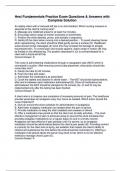Samenvatting
Summary Finance year 1 BUAS International Hotel management (Resit: week 11 2023)
Finance jaar 1 (Rob van Ginneken). Gegarandeerd succes voor je finance tentamen door middel van deze college uitwerkingen (Teams materiaal + hoofdstuk 1, 2 & 4 van het boekje), samenvattingen, uitgewerkte opdrachten en uitleg. Dit document heeft mij geholpen om als een van de weinigen een heel mooi...
[Meer zien]














